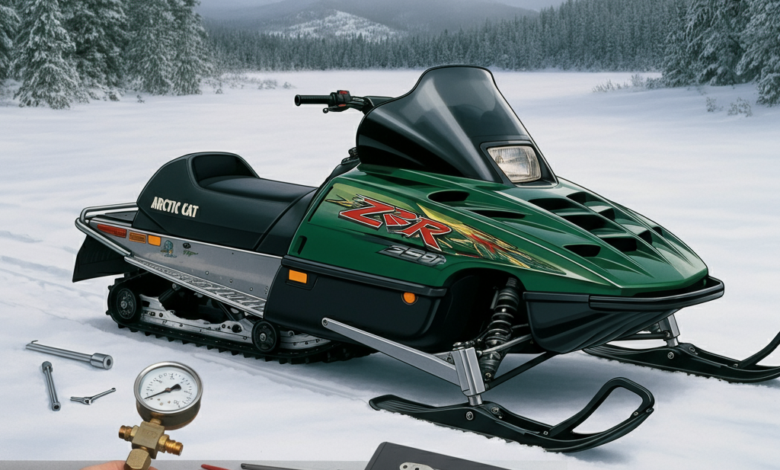A DIY Guide to Testing Fuel Pressure on the 1996 Arctic Cat ZR 580 EFI

The 1996 Arctic Cat ZR 580 EFI is a beloved machine among snowmobile enthusiasts. Known for its powerful performance, responsive Electronic Fuel Injection (EFI) system, and iconic design, it remains a top choice for thrill-seekers and hobbyists alike. However, like any snowmobile with an EFI system, the ZR 580 can run into fuel pressure issues over time, potentially affecting its performance.
If you’re an Arctic Cat owner or DIY mechanic, understanding your machine’s fuel pressure is crucial for diagnosing and maintaining optimal performance. This guide will walk you through everything you need to know about diagnosing, testing, and solving fuel pressure-related issues on the 1996 Arctic Cat ZR 580 EFI.
Understanding Fuel Pressure in EFI Systems
Fuel pressure is the backbone of any Electronic Fuel Injection (EFI) system. It ensures that the right amount of fuel is delivered to the engine at the right time, creating the ideal air-fuel mixture for combustion. Too little pressure can result in engine hesitation and poor performance, while too much can flood the engine, leading to issues like hard starting or black smoke from the exhaust.
For the 1996 Arctic Cat ZR 580 EFI, maintaining a consistent and appropriate fuel pressure is critical to achieving the throttle response and speed this snowmobile is known for.
Why Fuel Pressure Matters
- Performance: Proper fuel pressure ensures that your engine runs smoothly and delivers consistent power.
- Efficiency: A well-functioning EFI system optimizes fuel usage, preventing waste.
- Longevity: Addressing and maintaining fuel pressure prevents strain on components like the fuel pump and injectors, extending their lifespan.
Symptoms of Fuel Pressure Issues
How can you tell if your ZR 580 EFI has a fuel pressure problem? Here are some common signs to look out for:
- Difficulty starting the engine or inability to start.
- Poor throttle response or hesitation during acceleration.
- Engine misfires or stalls unexpectedly.
- Strong smell of fuel or black smoke coming from the exhaust.
- Reduced overall performance or top speed.
If you’ve noticed any of these symptoms, the first step is to test your fuel pressure to see if it’s the source of the problem.
Tools Needed for Pressure Testing
Before you begin testing your Arctic Cat’s fuel pressure, gather the following tools and supplies to make the process as smooth as possible:
- Fuel pressure gauge (compatible with fuel injection systems).
- Wrenches and screwdrivers (specific sizes may vary).
- Safety gloves and goggles.
- Shop towel or rag (to clean fuel spills).
- Replacement fuel line clamps (optional but recommended).
Having these tools ready will ensure you’re prepared to diagnose fuel-related issues.
Step-by-Step Guide to Testing Fuel Pressure
Here’s a simple, detailed guide to safely test the fuel pressure on your 1996 Arctic Cat ZR 580 EFI:
Step 1: Safety First
Make sure the snowmobile is in a well-ventilated area to avoid inhaling fumes. Engage the parking brake, turn off the ignition, and disconnect the negative battery terminal to prevent accidental sparking.
Step 2: Locate the Fuel Rail
Remove the hood to access the engine compartment. Locate the fuel rail, which is part of the EFI system and houses the connection point for the pressure gauge.
Step 3: Attach the Fuel Pressure Gauge
Connect the fuel pressure gauge to the test port on the fuel rail. Refer to the fuel gauge’s manual to ensure a secure connection.
Step 4: Turn on the Ignition
Reconnect the battery and turn the ignition key to the “ON” position without starting the engine. This will pressurize the fuel system and provide a reading on the gauge.
Step 5: Check the Gauge Reading
For the 1996 Arctic Cat ZR 580 EFI, the ideal fuel pressure range should be between 36 PSI and 42 PSI. Compare your results with the manufacturer’s specifications in the service manual.
Step 6: Interpret the Results
If the pressure is within the ideal range, your EFI system is functioning correctly. If it’s too high or too low, proceed to diagnose the cause.
Step 7: Safely Disconnect the Gauge
Turn off the ignition, release any residual fuel pressure using the appropriate valve on the gauge, and carefully disconnect the gauge from the fuel rail. Reassemble any components you removed.
Common Causes of Pressure Problems
If your readings indicate an issue, here’s what might be causing it:
- Clogged Fuel Filter: A dirty or clogged fuel filter can restrict fuel flow, resulting in low pressure.
- Failing Fuel Pump: If the pump can’t maintain consistent pressure, it might need repair or replacement.
- Leaking Fuel Injectors: Leaky injectors can result in a drop in pressure and reduced performance.
- Fuel Line Damage: Pinched, cracked, or leaking fuel lines can disrupt the flow of fuel.
Solutions for Fixing Fuel Pressure
- Replace clogged fuel filters promptly.
- Test the fuel pump’s performance (consult your service manual or a professional if needed).
- Repair or replace damaged fuel lines and clamps.
- Use injector cleaning kits or consult an expert for maintenance if injectors are leaking or clogged.
Maintenance Tips to Prevent Future Fuel Pressure Issues
Preventing fuel pressure issues is essential for keeping your Arctic Cat ZR 580 running smoothly. Follow these tips to maintain your EFI system:
- Regularly replace the fuel filter according to the manufacturer’s recommendations.
- Avoid old or contaminated fuel, as it can clog injectors and filters.
- Inspect fuel lines and connections periodically for wear and tear.
- Winterize your snowmobile properly to protect the fuel system during off-seasons.
These practices will ensure your snowmobile stays in peak condition and ready for any winter adventure.
Keep Your Arctic Cat Running Like a Dream
Fuel pressure is the lifeblood of your 1996 Arctic Cat ZR 580 EFI’s performance. By understanding its importance and knowing how to test and maintain it, you can keep your snowmobile running like the legend it is.